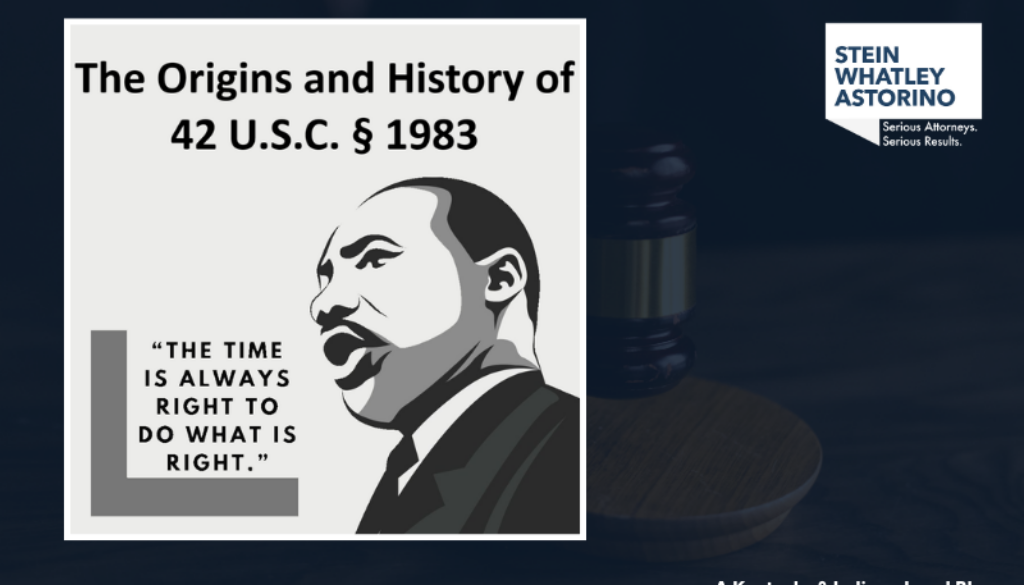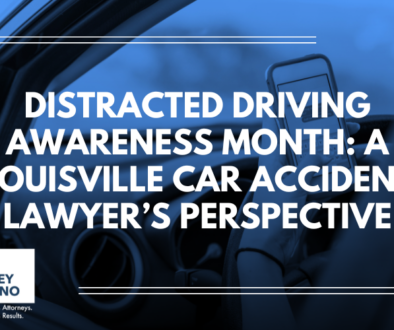The Origins and History of 42 U.S.C. § 1983
42 U.S.C. § 1983
42 U.S.C. § 1983, often referred to simply as Section 1983, is a fundamental statute in American civil rights law. It provides individuals with a mechanism to sue state officials and local governments for constitutional violations. Its origins, history, and evolution are deeply tied to the nation’s struggle with civil rights and federalism. This article explores the genesis, legislative intent, and subsequent development of Section 1983.
The Historical Context and Section 1983
Section 1983 is traced back to the tumultuous period following the American Civil War. 1865 marked the war’s end and the abolition of slavery followed soon after through ratification of the Thirteenth Amendment. However, in the post-war Reconstruction Era, southern states resisted the new constitutional order. Systemic racism and oppression persisted in parts of the United States. Black Codes were enacted in some states in response to the abolition of slavery. These codes severely restricted the freedoms and rights of African Americans.
In response, Congress sought to address these injustices and safeguard the civil rights of newly freed slaves and other vulnerable populations. Congress passed what are known as the Reconstruction Amendments. The Reconstruction Amendments — the Thirteenth, Fourteenth, and Fifteenth Amendments — establish equal protection under the law and prohibit racial discrimination. However, additional federal intervention was necessary because many southern states operated in defiance of the Amendments.
The Civil Rights Act of 1871
The Civil Rights Act of 1871 was the immediate precursor to Section 1983. The civil rights statute was commonly known as the Ku Klux Klan Act. Congressman Samuel Shellabarger introduced this legislation in response to widespread violence and intimidation orchestrated by groups like the Ku Klux Klan. These groups terrorized African Americans and other marginalized groups and blocked their participation in political and social life.
On April 20, 1871, Congress enacted legislation that provided the federal government with tools to combat racial terrorism and protect constitutional rights. We now recognize Section 1983 as one of its key provisions. Originally codified as Section 1 of the 1871 Act, it stated:
“Every person who, under color of any statute, ordinance, regulation, custom, or usage, of any State or Territory, subjects, or causes to be subjected, any citizen of the United States or other person within the jurisdiction thereof to the deprivation of any rights, privileges, or immunities secured by the Constitution and laws, shall be liable to the party injured in any action at law, suit in equity, or other proper proceeding for redress.”
Congress established a federal cause of action against state actors who violated constitutional rights. The law allowed individuals to seek redress in federal courts, therefore, bypassing state judicial systems exhibiting bias against African Americans and other marginalized groups.
Early Challenges and Limited Application of 42 USC 1983
Despite its promising objectives, Section 1983 initially had limited practical impact. The political compromise of 1877 marked the end of Reconstruction and federal enforcement of civil rights protections waned in the following years. The rise of Jim Crow laws entrenched racial segregation and disenfranchisement in the South. Many courts, including the Supreme Court of the United States, adopted a narrow interpretation of civil rights statutes and the Fourteenth Amendment.
Section 1983 remained largely dormant for decades. The Supreme Court’s decision in United States v. Cruikshank (1876) weakened federal oversight significantly. The ruling held the Fourteenth Amendment only restricted state action but not private conduct. Similarly, The Civil Rights Cases (1883) invalidated portions of the Civil Rights Act of 1875. The rulings eroded protections against racial discrimination further.
Revival and Expansion in the Twentieth Century
Section 1983 experienced a resurgence during the mid-twentieth century. The statute’s rise coincided with the rise of civil rights movement we know today. The Supreme Court’s landmark decision in Monroe v. Pape (1961) revitalized the statute. In this case, a Chicago family sued police officers who conducted an illegal search of their home without a warrant. The Court held that Section 1983 provided a remedy for constitutional violations committed by state officials even if those actions were unauthorized by state law.
Justice William O. Douglas wrote the majority opinion. He emphasized the importance of holding state actors accountable for abuses of power. Monroe expanded the scope of Section 1983. The ruling clarified that 1983 cases applied to actions taken “under color of” state law. It applied even if those actions violated state law. This interpretation ensured victims of constitutional violations had broader access to federal courts.
Key Developments and Doctrinal Shifts
Section 1983 became a cornerstone of civil rights litigation following Monroe v. Pape. Subsequent cases refined its application and addressed critical issues such as municipal liability, qualified immunity, and the relationship between federal and state courts.
Municipal Liability: In Monell v. Department of Social Services (1978), the Supreme Court ruled that local governments could be sued under Section 1983 if the constitutional violation resulted from an official policy or custom. This decision overturned earlier precedent set by Monroe that excluded municipal liability.
Qualified Immunity: The doctrine of qualified immunity emerged as a significant barrier to Section 1983 claims. The doctrine shields government officials from liability unless their actions violate “clearly established” constitutional rights. However, critics argue that this doctrine undermines accountability by making it difficult for plaintiffs to succeed in civil rights lawsuits.
State Sovereignty and Federalism: Section 1983 operates within the complex framework of federalism. The Eleventh Amendment grants states sovereign immunity from suit. So, sovereign immunity limits the ability of victims to sue states directly under Section 1983. However, individual state officials can be held liable for actions taken in their official capacities.
Modern Applications for 42 U.S.C. § 1983
Today, Section 1983 serves as a vital tool for addressing a wide range of constitutional violations, including police misconduct, wrongful imprisonment, and violations of free speech and religious freedoms. The statute empowers individuals to challenge systemic injustices and hold public officials accountable.
Police Misconduct: Police misconduct lawyers use Section 1983 frequently to address excessive force and other forms of police misconduct. Civil rights lawyers use this statute to seek accountability and justice for wrongfully killed individuals. The statutes were the center of national attention after the killings of George Floyd and Breonna Taylor. Section 1983 lawsuits provide financial compensation for victims, lead to institutional reforms, and increased scrutiny of law enforcement practices.
Prisoners’ Rights: The Incarcerated rely on Section 1983 to challenge inhumane conditions, denial of medical care, and violations of due process. These cases resulted in significant reforms in the treatment of prisoners and the management of correctional facilities.
First Amendment Protections: The statute safeguards free speech. It protects religious freedoms. It defends the right to protest. Victims can pursue remedies under Section 1983 when faced with retaliation for exercising these rights.
Educational Rights and Disability Protections: Civil rights attorneys use Section 1983 to address violations of students’ constitutional rights, which include cases involving discrimination, disability rights, and due process in disciplinary proceedings.
Modern Challenges for 42 U.S.C. § 1983
The statute faces significant challenges despite its broad applications:
Qualified Immunity: The doctrine of qualified immunity remains a controversial hurdle. Courts dismiss cases if the exact nature of the alleged violation is not “clearly established” in prior rulings. This practice creates a high bar for plaintiffs to overcome even in egregious cases of misconduct.
Procedural Barriers: Plaintiffs must navigate a complex legal landscape, including statutes of limitations, requirements to exhaust administrative remedies, and the burden of proving municipal liability. These barriers discourage or prevent individuals from pursuing valid claims.
Resource Imbalances: Individuals suing under Section 1983 often face well-funded defendants, such as state or municipal governments. The disparity makes litigation lengthy, expensive, and emotionally taxing.
Systemic Resistance: Efforts to reform police practices or hold public officials accountable often encounter institutional resistance. Often, even successful Section 1983 cases may result in limited changes if systemic issues are not addressed.
Emerging Issues: New challenges, such as the use of technology in law enforcement (e.g., facial recognition and surveillance tools), raise questions about how Section 1983 can adapt to protect constitutional rights in a digital age.
Section 1983 and Martin Luther King Jr. Day
Dr. King’s mission to combat racial injustice and secure equality for all Americans is deeply intertwined with the principles enshrined in Section 1983. As we remember Dr. King today, we should also appreciate Section 1983 and its foundational role in advancing civil rights. Moreover, this statute is a legal mechanism to uphold the continued constitutional protections for which Dr. King tirelessly advocated.
Dr. King’s dream of a just society requires moral leadership and robust legal protections. Our civil rights law firm is committed to ensuring that no individual, regardless of race, is denied his or her constitutional rights. It is fitting to for us to reflect on this Martin Luther King Jr. Day and appreciated the enduring significance of this statute and its role in advancing the cause of justice.
Conclusion
The origins and history of 42 U.S.C. § 1983 reflect the enduring struggle for civil rights and the evolving relationship between federal and state governments. Section 1983 plays a pivotal role in protecting constitutional rights and promoting justice. If properly wielded, it remains a powerful instrument for redress. Therefore, civil rights attorneys must be vigilant to ensuring that it fulfills its purpose in an equitable and effective manner.
At Stein Whatley Astorino, PLLC we have developed a strong civil rights practice prosecuting 1983 claims for people who have had their constitutional rights violated.
Call us if you believe that your constitutional rights have been violated, and you want to explore whether you have a 1983 case. The case evaluation is free and confidential.
502.553.4750.
Serious Attorneys. Serious Results.




